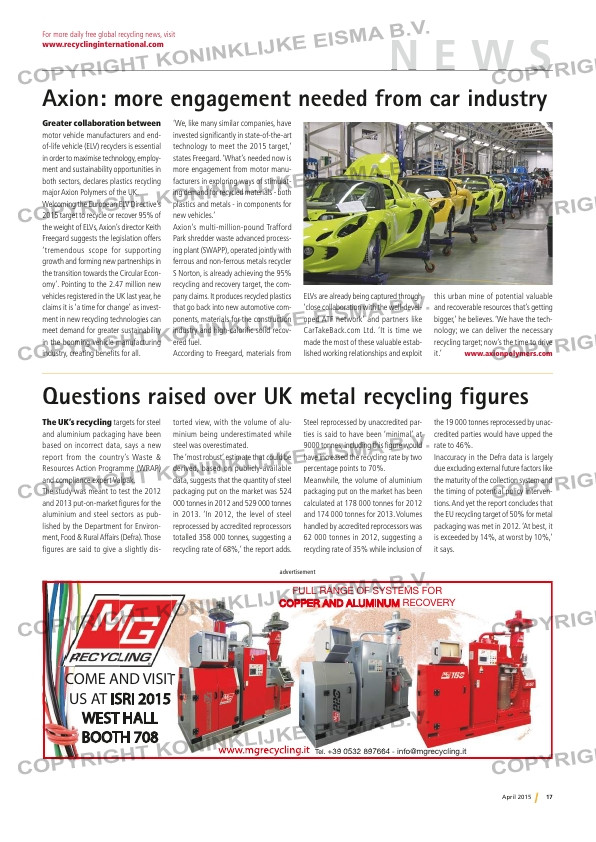Page 17 from: April 2015

N E W S
17April 2015
For more daily free global recycling news, visit
www.recyclinginternational.com
www.mgrecycling.it Tel. +39 0532 897664 – [email protected]
COME AND VISIT
US AT ISRI 2015
WEST HALL
BOOTH 708
FULL RANGE OF SYSTEMS FOR
COPPER AND ALUMINUM RECOVERY
advertisement
Greater collaboration between
motor vehicle manufacturers and end-
of-life vehicle (ELV) recyclers is essential
in order to maximise technology, employ-
ment and sustainability opportunities in
both sectors, declares plastics recycling
major Axion Polymers of the UK.
Welcoming the European ELV Directive’s
2015 target to recycle or recover 95% of
the weight of ELVs, Axion’s director Keith
Freegard suggests the legislation offers
‘tremendous scope for supporting
growth and forming new partnerships in
the transition towards the Circular Econ-
omy’. Pointing to the 2.47 million new
vehicles registered in the UK last year, he
claims it is ‘a time for change’ as invest-
ment in new recycling technologies can
meet demand for greater sustainability
in the booming vehicle manufacturing
industry, creating benefi ts for all.
‘We, like many similar companies, have
invested signifi cantly in state-of-the-art
technology to meet the 2015 target,’
states Freegard. ‘What’s needed now is
more engagement from motor manu-
facturers in exploring ways of stimulat-
ing demand for recycled materials – both
plastics and metals – in components for
new vehicles.’
Axion’s multi-million-pound Trafford
Park shredder waste advanced process-
ing plant (SWAPP), operated jointly with
ferrous and non-ferrous metals recycler
S Norton, is already achieving the 95%
recycling and recovery target, the com-
pany claims. It produces recycled plastics
that go back into new automotive com-
ponents, materials for the construction
industry and high-calorifi c solid recov-
ered fuel.
According to Freegard, materials from
ELVs are already being captured through
‘close collaboration with the well-devel-
oped ATF network’ and partners like
CarTakeBack.com Ltd. ‘It is time we
made the most of these valuable estab-
lished working relationships and exploit
this urban mine of potential valuable
and recoverable resources that’s getting
bigger,’ he believes. ‘We have the tech-
nology; we can deliver the necessary
recycling target; now’s the time to drive
it.’ www.axionpolymers.com
Axion: more engagement needed from car industry
The UK’s recycling targets for steel
and aluminium packaging have been
based on incorrect data, says a new
report from the country’s Waste &
Resources Action Programme (WRAP)
and compliance expert Valpak.
The study was meant to test the 2012
and 2013 put-on-market fi gures for the
aluminium and steel sectors as pub-
lished by the Department for Environ-
ment, Food & Rural Affairs (Defra). Those
fi gures are said to give a slightly dis-
torted view, with the volume of alu-
minium being underestimated while
steel was overestimated.
The ‘most robust’ estimate that could be
derived, based on publicly-available
data, suggests that the quantity of steel
packaging put on the market was 524
000 tonnes in 2012 and 529 000 tonnes
in 2013. ‘In 2012, the level of steel
reprocessed by accredited reprocessors
totalled 358 000 tonnes, suggesting a
recycling rate of 68%,’ the report adds.
Steel reprocessed by unaccredited par-
ties is said to have been ‘minimal’ at
9000 tonnes; including this fi gure would
have increased the recycling rate by two
percentage points to 70%.
Meanwhile, the volume of aluminium
packaging put on the market has been
calculated at 178 000 tonnes for 2012
and 174 000 tonnes for 2013. Volumes
handled by accredited reprocessors was
62 000 tonnes in 2012, suggesting a
recycling rate of 35% while inclusion of
the 19 000 tonnes reprocessed by unac-
credited parties would have upped the
rate to 46%.
Inaccuracy in the Defra data is largely
due excluding external future factors like
the maturity of the collection system and
the timing of potential policy interven-
tions. And yet the report concludes that
the EU recycling target of 50% for metal
packaging was met in 2012. ‘At best, it
is exceeded by 14%, at worst by 10%,’
it says.
Questions raised over UK metal recycling figures
RI-3 NEWS.indd 17 30-03-15 10:07



